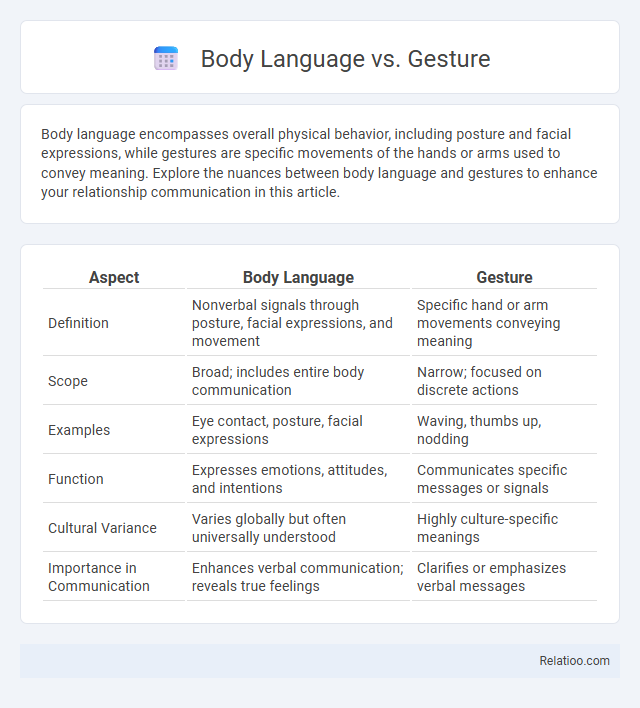Body language encompasses overall physical behavior, including posture and facial expressions, while gestures are specific movements of the hands or arms used to convey meaning. Explore the nuances between body language and gestures to enhance your relationship communication in this article.
Table of Comparison
| Aspect | Body Language | Gesture |
|---|---|---|
| Definition | Nonverbal signals through posture, facial expressions, and movement | Specific hand or arm movements conveying meaning |
| Scope | Broad; includes entire body communication | Narrow; focused on discrete actions |
| Examples | Eye contact, posture, facial expressions | Waving, thumbs up, nodding |
| Function | Expresses emotions, attitudes, and intentions | Communicates specific messages or signals |
| Cultural Variance | Varies globally but often universally understood | Highly culture-specific meanings |
| Importance in Communication | Enhances verbal communication; reveals true feelings | Clarifies or emphasizes verbal messages |
Understanding Body Language and Gestures
Body language encompasses the full range of nonverbal signals your body conveys, including posture, facial expressions, and movements, while gestures are specific, purposeful motions made with hands or arms to communicate distinct messages. Understanding body language helps you interpret these subtle cues, enhancing communication by revealing emotions and intentions beyond spoken words. Mastering the difference between body language and gestures empowers you to read social interactions more accurately and respond effectively.
Defining Body Language: Beyond Words
Body language encompasses the full range of nonverbal signals you communicate, including facial expressions, posture, and eye contact, which convey emotions and intentions beyond spoken words. Gestures are specific movements of the hands, arms, or head that form a subset of body language with more deliberate, often culturally influenced meanings. Understanding body language provides you with deeper insight into unspoken communication, enhancing your ability to interpret and respond effectively in social and professional interactions.
What Are Gestures? Key Differences Explained
Gestures are specific movements of the hands, arms, or other parts of the body that convey particular messages or emotions, distinct from the broader concept of body language which encompasses overall posture, facial expressions, and physical behavior. Unlike general body language that reveals subconscious feelings, gestures are often deliberate and culturally specific signals used to communicate. Understanding the key differences helps you interpret nonverbal communication more accurately by recognizing intentional gestures versus involuntary body language cues.
The Functions of Body Language in Communication
Body language functions as a powerful nonverbal communication tool that conveys emotions, attitudes, and reactions without spoken words, influencing interpersonal interactions and social dynamics. Gestures, as specific movements of the hands or body, serve to emphasize or clarify verbal messages, complementing spoken language through visual cues. Overall, body language encompasses a broader range of physical behaviors--including posture, facial expressions, and eye contact--that regulate conversations, express feelings, and establish relational contexts.
How Gestures Influence Human Interaction
Gestures play a crucial role in human interaction by conveying emotions and intentions nonverbally, enhancing communication clarity and engagement. Unlike broader body language, which includes posture and facial expressions, gestures specifically involve voluntary hand and arm movements that can emphasize speech or replace words entirely. Effective use of gestures fosters connection and understanding, often bridging cultural and linguistic gaps in conversations.
Cultural Variations in Gestures vs. Body Language
Cultural variations in gestures often carry specific, localized meanings that can differ dramatically across societies, whereas body language encompasses broader, more universal nonverbal cues such as posture and facial expressions. Misinterpreting gestures can lead to misunderstandings, while body language provides more consistent signals of emotions and intentions across cultures. Understanding these distinctions allows you to navigate diverse cultural contexts more effectively, improving communication and interpersonal connections.
Nonverbal Cues: Which Speak Louder?
Nonverbal cues such as body language and gestures convey emotions and intentions beyond verbal communication, with body language encompassing overall posture, facial expressions, and movement, while gestures refer to specific hand or arm actions. Studies show that body language often holds more weight in interpreting feelings because it provides a holistic context, whereas gestures serve as complementary signals that emphasize or clarify messages. Understanding the interplay between body language and gestures is essential for accurate decoding of nonverbal communication in social and professional interactions.
Interpreting Mixed Signals: When Gestures and Body Language Clash
Interpreting mixed signals requires understanding the subtle differences between body language and gestures, as body language encompasses overall posture, facial expressions, and movements, while gestures are specific hand or arm motions. When your gestures contradict your body language, such as a nodding head paired with crossed arms, it can create confusion and signal conflicting emotions to others. Recognizing these inconsistencies helps you decipher true feelings and intentions behind the mixed signals.
Enhancing Communication with Conscious Movements
Body language encompasses the full range of nonverbal signals, including facial expressions, posture, and gestures, that convey emotions and intentions in communication. Gestures, as specific body movements like hand waves or nods, serve as intentional cues to emphasize or clarify verbal messages and enhance understanding. Conscious movement enhances communication by promoting awareness and control over these nonverbal signals, allowing individuals to express confidence, empathy, and engagement effectively.
Mastering the Art of Nonverbal Expression
Mastering the art of nonverbal expression involves understanding the distinctions between body language, gestures, and facial expressions. Body language encompasses the overall posture, movements, and physical behaviors that convey emotions and intentions, while gestures are specific, intentional motions used to communicate particular messages. Developing proficiency in reading and controlling these nonverbal cues enhances communication effectiveness and interpersonal connection.

Infographic: Body language vs Gesture
 relatioo.com
relatioo.com